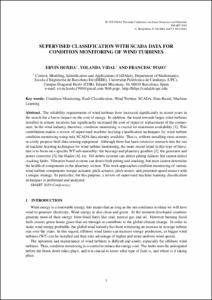Mostra el registre d'ítem simple
Supervised classification with SCADA data for condition monitoring of wind turbines
| dc.contributor.author | Hoxha, Ervin |
| dc.contributor.author | Vidal Seguí, Yolanda |
| dc.contributor.author | Pozo Montero, Francesc |
| dc.contributor.other | Universitat Politècnica de Catalunya. Doctorat en Matemàtica Aplicada |
| dc.contributor.other | Universitat Politècnica de Catalunya. Departament de Matemàtiques |
| dc.date.accessioned | 2019-09-27T12:43:28Z |
| dc.date.available | 2019-09-27T12:43:28Z |
| dc.date.issued | 2019 |
| dc.identifier.citation | Hoxha, E.; Vidal, Y.; Pozo, F. Supervised classification with SCADA data for condition monitoring of wind turbines. A: ECCOMAS Thematic Conference Smart Structures and Materials. "9th ECCOMAS Thematic Conference on Smart Structures and Materials". 2019, p. 263-273. |
| dc.identifier.isbn | 978-84-949194-6-6 |
| dc.identifier.uri | http://hdl.handle.net/2117/168838 |
| dc.description.abstract | The reliability requirements of wind turbines have increased significantly in recent years inthe search for a lower impact on the cost of energy. In addition, the trend towards larger wind turbinesinstalled in remote locations has significantly increased the cost of repair or replacement of the compo-nent. In the wind industry, therefore, condition monitoring is crucial for maximum availability [1]. Thiscontribution makes a review of supervised machine learning classification techniques for wind turbinecondition monitoring using only SCADA data already available. That is, without installing extra sensorsor costly purpose-built data sensing equipment. Although there has been extensive research into the useof machine learning techniques for wind turbine monitoring, the more recent trend in this type of litera-ture is to focus on a specific WT sub-assembly: the bearings and planetary gearbox [2], the generator andpower converter [3], the blades [4], etc. Oil debris systems can detect pitting failures but cannot detectcracking faults. Vibration based systems can detect both pitting and cracking, but most cannot determinethe health of components in the planetary section. This work approaches condition monitoring of variouswind turbine components (torque actuator, pitch actuator, pitch sensor, and generator speed sensor) witha unique strategy. In particular, for this purpose, a review of supervised machine learning classificationtechniques is performed and analyzed. |
| dc.format.extent | 11 p. |
| dc.language.iso | eng |
| dc.rights | Attribution-NonCommercial-NoDerivs 3.0 Spain |
| dc.rights.uri | http://creativecommons.org/licenses/by-nc-nd/3.0/es/ |
| dc.subject | Àrees temàtiques de la UPC::Matemàtiques i estadística |
| dc.subject.lcsh | Wind turbines |
| dc.subject.other | Condition Monitoring |
| dc.subject.other | Fault Classification |
| dc.subject.other | Wind Turbine |
| dc.subject.other | SCADA |
| dc.subject.other | Data Based |
| dc.subject.other | Machine Learning |
| dc.title | Supervised classification with SCADA data for condition monitoring of wind turbines |
| dc.type | Conference report |
| dc.subject.lemac | Aerogeneradors |
| dc.contributor.group | Universitat Politècnica de Catalunya. CoDAlab - Control, Modelització, Identificació i Aplicacions |
| dc.rights.access | Open Access |
| local.identifier.drac | 25624034 |
| dc.description.version | Postprint (published version) |
| local.citation.author | Hoxha, E.; Vidal, Y.; Pozo, F. |
| local.citation.contributor | ECCOMAS Thematic Conference Smart Structures and Materials |
| local.citation.publicationName | 9th ECCOMAS Thematic Conference on Smart Structures and Materials |
| local.citation.startingPage | 263 |
| local.citation.endingPage | 273 |


